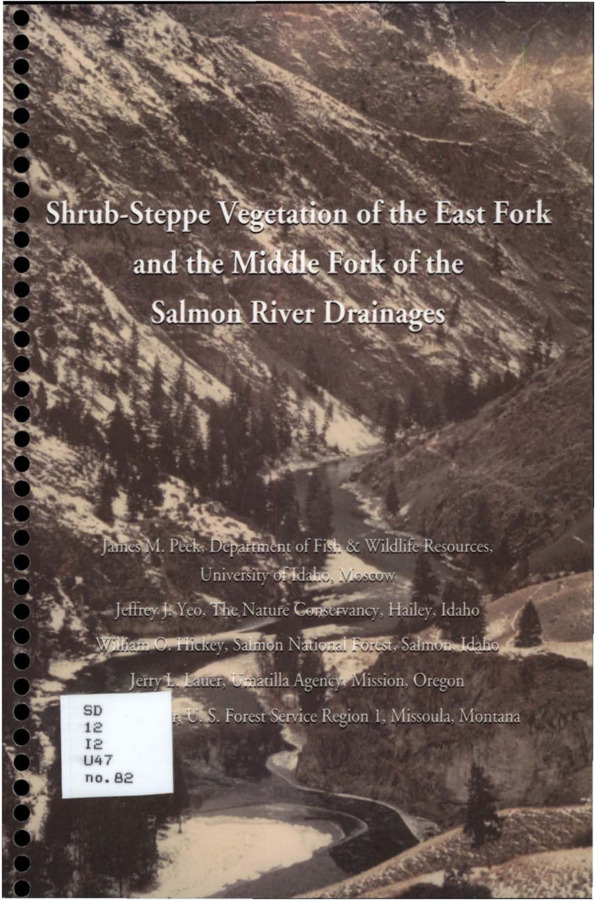PDF
Shrub-Steppe Vegetation of the East Fork and the Middle Fork of the Salmon River Drainages Item Info
- Title:
- Shrub-Steppe Vegetation of the East Fork and the Middle Fork of the Salmon River Drainages
- Authors:
- Peek, James M. Yeo, Jeffrey J. Hickey, William O. Lauer, Jerry L. Claar, James C.
- Date Created:
- 2005
- Description:
- Authors describe nineteen shrub-steppe communities in the Middle Fork and East Fork of the Salmon River, Idaho. Bluebunch wheatgrass (Pseudoroegneria spicata) and Idaho fescue (Festuca idahoensis) occur as dominants or major subdominants throughout the region. Big sagebrush (Artemesia tridentata), threetip sagebrush (A. tripartita), and low sagebrush (A.arbuscula) are dominants, especially in the East Fork and southern Middle Fork. Antelope bitterbrush (Purshia tridentata) communities exist throughout the region but are most abundant along the Middle Fork, where the species also occurs as a dominant in the understory of ponderosa pine (Pinus ponderosa) and Douglas fir (Pseudotsuga menziesii) stands on drier sites. Cliffy areas in all regions have curlleaf mountain mahogany (Cercocarpus ledifolius) and little greenbush (Glossopetalon nevadense) stands, reflecting the specialized habitats on which these communities occur. Shadscale saltbush (Atriplex confertifolia) communities occupy the driest sites in the lower East Fork. Common snowberry (Symphoricarpos albus), antelope bitterbrush, big sagebrush, threetip sagebrush, Idaho fescue, bluebunch wheatgrass, and needle-and-thread (Hesperostipa comata) are well represented in the plant communities. Bluebunch wheatgrass or Idaho fescue or both dominate grassland communities. Needle-and-thread dominates on some xeric, sandy sites. The presence of ponderosa pine or Douglas fir in shrub communities suggests these are successional stages of conifer-dominated community types. At least six conifer communities are represented in ten stands dominated by common snowberry, in thirteen dominated by ninebark (Physocarpus malvaceus), five dominated by Idaho fescue, and three dominated by mountain big sagebrush (Artemisia tridentata ssp. vaseyana). Seven sites exclosed between 1915 and 1950 provide evidence of reduction in shrubs and expansion of grassland and herbaceous portions of these communities in the Middle Fork. A record of a stand photographed in 1925, 1968, and 1988 appears to corroborate these findings. Changes in species composition of these communities are attributed to changes in species of herbivores, including livestock, mule deer, and elk; to alterations in the natural fire regime; and to weather patterns that affected woody and herbaceous plants differently over the period. The major fire of 2000 in the Middle Fork drainage appears to have increased cheatgrass (Bromus tectorum) at least temporarily, and to have reduced nonresprouting shrubs including big sagebrush, curlleaf mountain mahogany, and antelope bitterbrush. Subsequent establishment of new plants from seeds has occurred on sites burned in the most recent fires. Productivity of bluebunch wheatgrass was reduced for one year following the 2000 fire.
- Relation:
- Station Bulletin 82
- Source:
- Idaho QH76.5 I2 U47, University of Idaho Library Special Collections and Archives, http://www.lib.uidaho.edu/special-collections/
- Type:
- Text
- Format:
- application/pdf
Source
- Preferred Citation:
- "Shrub-Steppe Vegetation of the East Fork and the Middle Fork of the Salmon River Drainages", Idaho Forest, Wildlife, and Range Experiment Station Collection, University of Idaho Library Digital Collections, https://www.lib.uidaho.edu/digital/fwres/items/fwres51.html
Rights
- Rights:
- Educational use includes non-commercial use of text and images in materials for teaching and research purposes. Digital reproduction permissions granted by the University of Idaho Library. For other uses beyond free use, please contact University of Idaho Library Special Collections and Archives Department at libspec@uidaho.edu.
- Standardized Rights:
- http://rightsstatements.org/vocab/InC-EDU/1.0/

